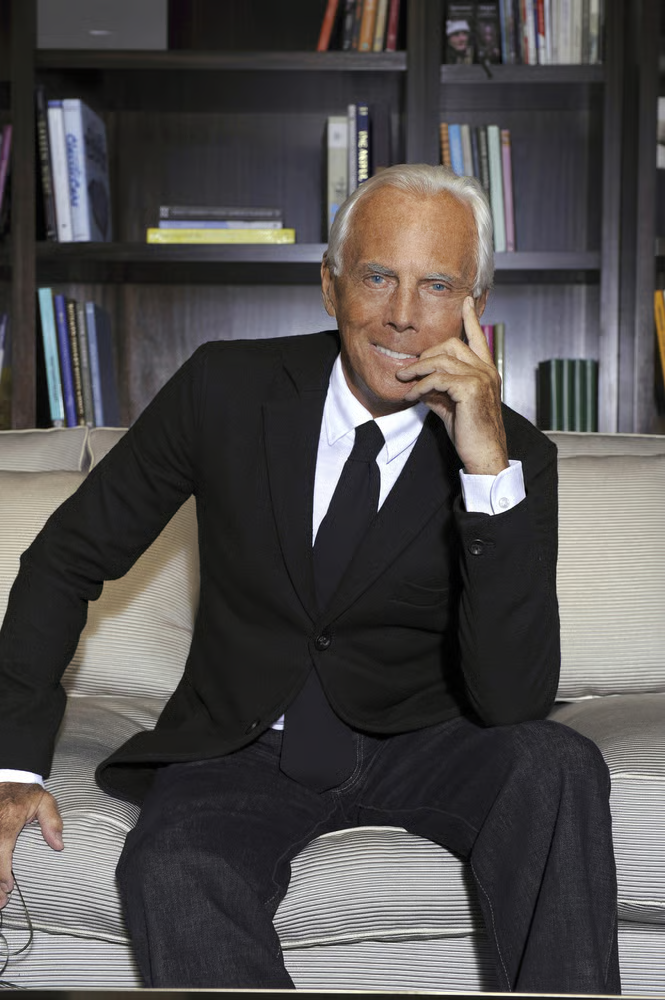Giorgio Armani: The Tailor of Desire
The city of Milan has always hummed with elegance. But on that early September evening, it didn’t hum. It sighed. The streets were unusually quiet, as if the architecture itself had bowed in mourning. High above Via Manzoni, in a penthouse bathed in soft ochre light, the tailor of modern seduction exhaled for the final time.
Giorgio Armani was dead. But his legend had only just begun to undress.
He was not just a fashion designer. He was not just an empire-builder. He was an architect of self-possession. Of silence that shouted. Of lines that seduced more skin than they covered. Giorgio Armani didn’t just design clothing—he designed how it felt to want someone before a word had been spoken.
Born in Piacenza in 1934, he was never meant to rule fashion. Medicine called first, then photography, then retail. But none of it fit quite right. Only when he laid hands on fabric—on form—did he recognize his true canvas: the human body in motion.
His genius wasn’t flamboyance. It was restraint. He removed what was unnecessary until only the essential remained. And in that space, he created a wardrobe not for the season—but for the soul.
Men walked taller in Armani. Women moved like water. Everyone looked like they had a secret. That was his brand: mystery, styled.
The world first understood the depth of his eroticism in 1980. American Gigolo. Richard Gere. A closet full of Giorgio.
There were no logos. No flash. Just drape. Just movement. Just the sense that something dangerous could happen if you unbuttoned one more notch.
From that moment, Hollywood was his.
And through it, so was the world.
His suits didn’t protect you. They dared you. They whispered, I don’t need to be loud. I am the moment. They made the wearer—and the viewer—ache for a touch, a taste, a reason to lean in.
No one had ever made wool feel like foreplay.
While others built empires through scale, Armani built his through seduction. Every store a sanctuary. Every campaign a mood. Every collection a lesson in desire.
He launched Emporio Armani for the rising class. Armani Exchange for the dreamers. Armani Casa for the sensual minimalists. Hotels, fragrances, even floral arrangements—all cut with his signature restraint.
And he never gave it away. Never sold out. He retained control of it all.
Because power, he understood, is quiet.
He didn’t scream wealth. He wore it. He didn’t demand attention. He edited everything until he became the only thing you could see.
Cate. Julia. Michelle. Princesses. CEOs. Lovers.
Armani dressed them all. But he never dressed them to please others. He dressed them to feel themselves more deeply.
A well-cut Armani dress could quiet a boardroom. A satin pantsuit could make a prince pause. His womenswear wasn’t about showing skin. It was about showing steel.
He gave women the tools to be seen on their terms.
He didn’t design for the female body. He designed for the female will.
Walk into the Armani Hotel in Dubai. Everything—from the scent of the air to the weight of the drapes—is foreplay.
The bed is the kind that asks questions. The bathroom mirror forgives your sins. The robe doesn’t close unless you want it to.
This was Armani too.
He understood that style wasn’t what you wore. It was what surrounded you. How you entered a room. How you left it. How long they remembered the shape of your presence.
In the Armani world, nothing is accidental. Every angle curated. Every silence composed. Every touchpoint—from the minibar to the monogrammed slippers—was a signature.
Because seduction doesn’t start in the bedroom.
It starts the moment the door clicks shut.
He never married. Never flaunted romance. But love existed in every fold of fabric. His relationships were tailored too: private, intentional, intimate.
The rumor mill spoke of quiet passions, of shared penthouses in Milan, of smiles exchanged across runways. But Armani never confirmed. He didn’t need to. His life was an invitation to imagine, not to intrude.
In an industry addicted to exposure, he chose mystery. In a world obsessed with oversharing, he remained a silhouette behind a veil of cashmere.
His final runway, unseen by most, was not a spectacle—it was a confession. Models glided like ghosts in ivory and ink. Music lingered like memory. And when the last look turned, the lights didn’t drop.
They faded slowly, like the end of a song that’s been part of your life for decades.
Backstage, he stood. Thinner than before. More fragile. But his eyes still cut like a razor. He nodded once. The team exhaled.
And that was it.
In death, he became myth. The man who made quiet sexy. The man who sold confidence in charcoal gray.
Milan named a street after him. Hollywood reran Gigolo. Editors pulled out vintage Armani covers and called them “timeless.” But those who knew better understood—his legacy wasn’t in magazines.
It was in the way a woman zips up a dress before a deal. In the pause a man takes before tying a shoelace that was handmade in Parma.
Armani wasn’t fashion. He was feeling.
You don’t bury a man like Giorgio Armani. You wear him.
In your walk. In your wristwatch. In the silence you let linger after you’ve said something important.
He didn’t scream. He didn’t sell. He seduced. One clean line at a time.
And in the quiet luxury of every tailored moment, he still does.







